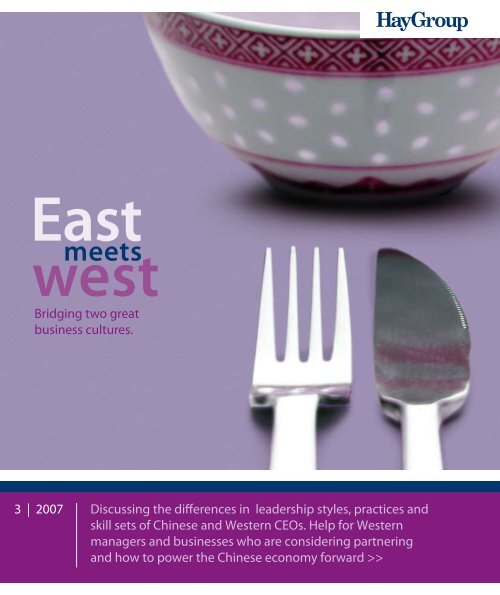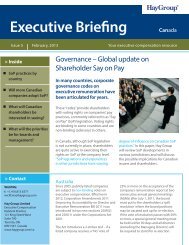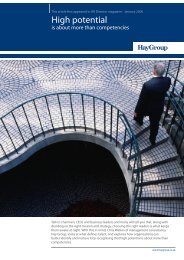East meets west - Hay Group
East meets west - Hay Group
East meets west - Hay Group
You also want an ePaper? Increase the reach of your titles
YUMPU automatically turns print PDFs into web optimized ePapers that Google loves.
<strong>East</strong><br />
<strong>meets</strong><br />
<strong>west</strong><br />
Bridging two great<br />
business cultures.<br />
3 | 2007<br />
Discussing the differences in leadership styles, practices and<br />
skill sets of Chinese and Western CEOs. Help for Western<br />
managers and businesses who are considering partnering<br />
and how to power the Chinese economy forward >>
Contents<br />
The challenge of China 1<br />
The study 2<br />
Three unique strengths of Chinese CEOs 2<br />
The quest for self improvement 4<br />
Three challenges facing Chinese CEOs 5<br />
Perspectives for Western executives in China 8<br />
Conclusion 9<br />
The sample 10
00 <strong>East</strong> <strong>meets</strong> West<br />
“<br />
Chinese CEO attributed<br />
their sustained business<br />
success to their sense<br />
of moral or social<br />
responsibility.<br />
”<br />
©2007 <strong>Hay</strong> <strong>Group</strong>. All rights reserved
1<br />
The challenge of China<br />
China is becoming ever more attractive as a market. In a recent<br />
survey of global senior executives across 19 industries which was<br />
jointly conducted by the <strong>Hay</strong> <strong>Group</strong> and Economist Intelligence<br />
Unit, over 80 per cent stated that they expected to be doing<br />
business in China within three years.<br />
Commercial liberalisation of the largest<br />
and most populous economy in the world<br />
is allowing companies to tap huge pentup<br />
demand. Add to this China’s ability<br />
to attract billions of dollars of foreign<br />
investment; the steady deregulation of its<br />
industries and we have a clear explanation<br />
for its projected annual growth rate over<br />
the next five to ten years of 8-9 per cent.<br />
With many organisations looking for<br />
new markets for their products and<br />
services; seeking to forge new supplier<br />
relationships or to acquire new<br />
manufacturing capability in China,<br />
<strong>Hay</strong> <strong>Group</strong> conducted an in-depth study<br />
of successful CEOs of Chinese enterprises.<br />
We wanted to understand the strengths<br />
and the particular competencies that<br />
underpin China’s phenomenal growth<br />
– the competencies that its best business<br />
leaders have used to deliver excellent<br />
business results. Understanding these<br />
characteristics can provide guidance for<br />
aspiring Chinese CEOs, as well as giving<br />
Western businesses insight into issues<br />
to consider when working with Chinese<br />
CEOs.<br />
The study yielded interesting findings.<br />
This group of Chinese CEOs<br />
demonstrated a unique set of skills which<br />
enabled them to thrive in the Chinese<br />
social and economic environment. In<br />
comparison to business leaders globally,<br />
they have significant strengths as well as<br />
certain skills gaps which may affect how<br />
they compete in the global market.
00 2 <strong>East</strong> <strong>meets</strong> West<br />
The study<br />
Conducted over the course of 18 months, the <strong>Hay</strong> <strong>Group</strong> study comprised<br />
rigorous in-depth, behavioural event interviews, as well as extensive surveys<br />
of the CEOs and their direct reports of 37 Chinese organisations. During the<br />
interviews, each CEO spent three hours recounting stories of what they said,<br />
thought and felt as they encountered some of their most important recent<br />
business experiences.<br />
The surveys included a Picture Story Exercise, reflecting the leaders’ nonconscious<br />
concerns and motives – the underlying drivers of their behaviours.<br />
A Personal Values Questionnaire indicated their conscious values and our<br />
Individual Learning Style Inventory showed how they process information and<br />
make decisions.<br />
In addition, most participants and a group of their direct reports also completed<br />
surveys regarding their leadership style and the organisational climate that they<br />
created.<br />
Three unique strengths of Chinese CEOs<br />
Our study revealed a number of specific<br />
and sometimes unique skills and<br />
competencies amongst Chinese CEOs.<br />
Social responsibility<br />
What is perhaps most surprising,<br />
given the widely-held perception of<br />
the tendency of Chinese business to<br />
corruption, is the frequency with which<br />
social responsibility featured in the<br />
interviews and in the events recounted.<br />
Anecdotes in which the leaders acted<br />
according to their sense of social<br />
responsibility featured most frequently<br />
in the events with the best business<br />
outcomes, and among the fastest growing<br />
businesses.<br />
At its core, social responsibility, as seen<br />
in the best Chinese CEOs, involves<br />
conducting business in a manner designed<br />
to improve the business environment,<br />
particularly in one’s own area or industry.<br />
This can involve actively supporting<br />
stronger regulation of one’s own industry;<br />
the refusal to participate in common<br />
but ‘unfair’ business practices or even<br />
voluntarily limiting one’s own profits<br />
to a reasonable level for the good of the<br />
industry and the society.<br />
©2007 <strong>Hay</strong> <strong>Group</strong>. All rights reserved
3<br />
One example is of a CEO of a business<br />
specialising in furniture trading.<br />
Concerned at the lack of control and<br />
corporate governance that they had<br />
witnessed within their large organisation,<br />
this leader was constructing a new<br />
management structure. The objective was<br />
to establish rigorous accountability for<br />
fair business practices as well as increasing<br />
employee motivation through profit<br />
sharing.<br />
Leaders demonstrating this competence<br />
are likely to act according to these values<br />
and to ensure that normal business<br />
practices in their organisation are<br />
consistent with them. They may also<br />
promote social values both inside and<br />
outside the company and ‘fight’ for them<br />
even at the cost of short term profit, or<br />
the displeasure of their peers.<br />
In this way, some of the very best Chinese<br />
businessmen are actually striving to<br />
build a healthy and responsible economic<br />
system. These leaders felt they had little in<br />
the way of precedent within the Chinese<br />
economy and so were using their own<br />
judgement as a guide and using their own<br />
behaviours to promote transparency and<br />
integrity.<br />
Chinese CEOs also attributed their<br />
sustained business success to their sense<br />
of moral or social responsibility. As<br />
one said, “corporate culture is closely<br />
related to the personality of the top<br />
leader… Only when you have high moral<br />
standards can you lay the founding stone<br />
of success.” Such stories provide cause for<br />
optimism among Western companies who<br />
are considering doing business in China<br />
but who are concerned about standards of<br />
probity and governance. However, there is<br />
still progress to be made in this area.<br />
Harmony<br />
Other Chinese leadership competencies<br />
complement and support this sense of<br />
social responsibility. The seeking of<br />
harmony in business relations is a striking<br />
example. Chinese leaders are often faced<br />
with complex, multi-party negotiations<br />
involving other businesses and different<br />
parts of the local and/or national<br />
government – situations that would tax<br />
anyone’s negotiating skills.<br />
The best Chinese CEOs display<br />
a distinctive and effective way of<br />
negotiating these complex environments.<br />
They do so in such a way as to create a<br />
harmonious result in which all parties<br />
are at least reasonably satisfied with the<br />
result.<br />
Achieving this degree of harmony<br />
involves complex influence strategies<br />
designed to bring each party to support<br />
the same solution. Chinese CEOs<br />
construct and present several alternatives<br />
in such a way that each party will<br />
voluntarily choose the same alternative<br />
– the one the leader sees as best overall.<br />
Care is taken to ensure that no party<br />
fully ‘wins’ at the expense of others. The<br />
foundation of this competency is an<br />
assumption that the relationships will be<br />
long-lasting – it is in no one’s interest for<br />
one side to be seen as totally ’winning.‘<br />
Western leaders would do well to learn<br />
how to understand the perspectives<br />
and concerns of their counterparts<br />
and observe how Chinese CEOs craft<br />
mutually satisfactory options in this way.<br />
However, Chinese CEOs want to improve<br />
not only their society and their business<br />
relationships, but also themselves.
00 4 <strong>East</strong> <strong>meets</strong> West<br />
The quest for self improvement<br />
Our study identified a marked lack of<br />
complacence amongst Chinese business<br />
leaders when it came to their own abilities<br />
and an appetite for continuous self<br />
improvement.<br />
This competency is manifested in a<br />
willingness to review and reflect on<br />
oneself, to learn from experience and to<br />
improve on performance and behaviour.<br />
It is based on an awareness of one’s<br />
own behavioural patterns, attitudes and<br />
moods; recognition of one’s own limits<br />
and a desire to learn and to do better.<br />
It is associated with better business results<br />
when it is associated with taking practical<br />
action to improve and inspiring others to<br />
do the same.<br />
Business leaders exhibiting this<br />
competency are also likely to request<br />
feedback and advice for improvement and<br />
seek continuous improvement in their<br />
own skills and behaviour as much as in<br />
their business results. They organise teams<br />
to conduct their own self reflection and<br />
take actions to implement changes based<br />
on it, sometimes making this a special<br />
event for the organisation.<br />
While from a Western perspective this<br />
process might be unnerving to witness,<br />
self–criticism is considered a virtue in<br />
China and can be a valuable exercise both<br />
at the personal and the organisational<br />
level.<br />
In the <strong>Hay</strong> <strong>Group</strong> study, one CEO<br />
practised Buddhist meditation to check<br />
his own temper and impatience. Another<br />
judged the fortunes of his organisation to<br />
be tied to its ability to acquire knowledge<br />
and contacts globally. Mastering spoken<br />
English, he argued, was essential not only<br />
for him, but, also for his team.<br />
Chinese CEOs may have to exploit<br />
these characteristics further in order<br />
to fully address the challenges they<br />
face. Appreciating the virtuous intent<br />
behind such critiques should encourage<br />
Western leaders to share best practice and<br />
expertise. In so doing, they will not only<br />
help their Chinese partners to improve<br />
but grow and improve themselves.<br />
Self–criticism is<br />
considered a virtue<br />
in China and can be a<br />
valuable exercise both<br />
at the personal and the<br />
organisational level.<br />
©2007 <strong>Hay</strong> <strong>Group</strong>. All rights reserved
5<br />
Three challenges facing Chinese CEOs<br />
Many Chinese businesses seek to<br />
expand and to become international<br />
or global. However, they face three<br />
particular challenges. While these three<br />
areas highlight room for improvement<br />
within the Chinese domestic market,<br />
they become even more important in<br />
the light of the international ambitions<br />
of many Chinese businesses.<br />
Talent management<br />
China, like many other parts of the<br />
world, is facing a significant shortage in<br />
talent. The situation is particularly acute<br />
as firms are undergoing rapid expansion<br />
and with scarcity driving up wages, high<br />
turnover is a key issue.<br />
Some 23 out of the 30 CEOs surveyed<br />
identified talent management as one of<br />
their own three biggest challenges.<br />
However, while talent management<br />
was identified as a critical issue, only<br />
six leaders actually told stories about<br />
developing or managing talent. Of these,<br />
only three indicated real success. Perhaps<br />
one reason for the lack of attention to<br />
talent is that rather than addressing talent<br />
management issues, Chinese CEOs are<br />
devoting a significant amount of time to<br />
raising capital – a responsibility normally<br />
associated in the West with the role of<br />
the chief financial officer.<br />
Clearly, in the future, the ability to<br />
fill the talent gap will be critical to the<br />
success of Chinese CEOs, as much as<br />
CEOs elsewhere. They must develop<br />
their ability to build organisational<br />
capability in order to be successful.<br />
This requires a commitment on the part<br />
of leaders to taking practical action to<br />
improve the long term talent capability<br />
of their organisation.<br />
In practice this involves ensuring that<br />
the right people are in key strategic roles.<br />
It is also demonstrated by establishing<br />
the operating systems and processes and<br />
organisational structures necessary to<br />
respond to current skills shortages in<br />
capability as well as to develop capability<br />
in the long term.<br />
Leaders possessing this competence<br />
in good measure will be concerned to<br />
foster the long-term development of<br />
others, and will seek to leave a legacy<br />
by developing good leaders who will be<br />
ready to take over.<br />
Organisational climate<br />
The question of the organisational<br />
climate created by the leader is a<br />
significant one as the success of an<br />
organisation depends on fully engaging<br />
the efforts and commitment of the top<br />
team and larger employee population,<br />
not just the CEO.<br />
While the tendency towards self<br />
criticism has already been noted as a<br />
distinctively Chinese management trait<br />
and one that will be new to many in<br />
the West, our interviews also identified<br />
other leadership styles which could<br />
initially be confusing to Westerners.<br />
The Chinese leadership style is<br />
predominantly paternalistic in nature.<br />
Chinese CEOs are less likely to give
00 6 <strong>East</strong> <strong>meets</strong> West<br />
rationales for decisions and more inclined<br />
to issue directives – this is known as the<br />
‘directive’ leadership style. At the same<br />
time, Chinese leaders communicate a sense<br />
of caring for their people – an ‘affiliative’<br />
style. They also often demonstrate concern<br />
for the education and development of<br />
their reports in a manner consistent with<br />
Chinese cultural values for education<br />
through a ‘coaching’ style.<br />
Chinese leaders are much less likely to<br />
manifest a ‘visionary’ style of leadership<br />
– involving the provision of a clear overall<br />
vision, direction and explanation. Nor<br />
do Chinese leaders much seek to involve<br />
their team in decision-making – otherwise<br />
known as the ‘participative’ style.<br />
This typically Chinese, paternalistic style<br />
can be disconcerting to Westerners and<br />
is not the most effective possible style<br />
for Chinese employees. Our study found<br />
that when Chinese leaders do include the<br />
visionary style as one of their strengths,<br />
they produce much more energising<br />
climates. Within the group of leaders<br />
we studied, the visionary style and its<br />
associated more energising climate were<br />
also more characteristic of the fastergrowing<br />
businesses.<br />
One of the consequences of the CEOs’<br />
leadership styles is that the climate, as<br />
experienced by their direct reports, is less<br />
energising than it could be. Substantial<br />
gaps are found between the ‘ideal’<br />
climate dimensions these CEOs’ direct<br />
reports aspire for and the ‘actual’ climate<br />
they are experiencing. The biggest gap<br />
lies within the area of cooperation or<br />
‘team commitment.’ Currently, the<br />
direct reports to Chinese CEOs do<br />
not seem to exhibit the level of team<br />
commitment and collaboration needed<br />
for performing well as a team.<br />
While some of them might contribute<br />
to this by preferring to work directly<br />
to the CEO, the CEO can promote<br />
more effective teamwork by providing<br />
clarity and by seeking the team’s ideas<br />
and input. This style of leadership<br />
simultaneously helps to develop<br />
the capabilities of the direct reports<br />
themselves.<br />
The question of leadership styles<br />
is of particular interest in light of<br />
many Chinese companies’ interest in<br />
international expansion — which will<br />
necessitate leading international teams.<br />
Widening their range of leadership styles,<br />
to include the visionary and participative<br />
styles, could help energise the current<br />
Chinese teams as well as enable the<br />
Chinese leaders to get top performance<br />
from global teams.<br />
Innovation: from red sea to blue ocean<br />
The rapidly growing Chinese economy<br />
is testament to the energy and high<br />
achievement drives of Chinese CEOs.<br />
Their energy and commitment to<br />
delivery is documented in our survey<br />
findings with ‘entrepreneurial growth’<br />
rating as the highest scoring competency<br />
demonstrated by Chinese CEOs.<br />
This energy and high achievement drive<br />
is demonstrated, for example, in the<br />
ability of Chinese businesses to replicate<br />
processes and operations, adapting them<br />
in order to deliver improved efficiency<br />
and cost.<br />
However, with markets opening<br />
up and globalisation taking hold,<br />
China’s fledgling private businesses are<br />
experiencing more intense competition.<br />
After 20 or so years of rapid growth,<br />
many Chinese companies have witnessed<br />
narrowing margins and decreasing profit.<br />
©2007 <strong>Hay</strong> <strong>Group</strong>. All rights reserved
7<br />
China, like many other<br />
parts of the world, is<br />
facing a significant<br />
shortage in talent.<br />
Many of them believe that foreign markets<br />
may present better profit opportunity.<br />
They are also supported by the government<br />
in their intention to go global.<br />
This presents many Chinese CEOs with<br />
a challenge. In order to compete abroad,<br />
they can no longer rely on their highly<br />
developed skills as adaptors. In order to<br />
compete they must generate value and/ or<br />
differentiate, they must innovate.<br />
In place of the low cost, mass market<br />
‘red sea’ model currently employed,<br />
many Chinese leaders already aspire to a<br />
new ‘blue ocean’ strategy of competing<br />
on the basis of quality, innovation or<br />
other differentiating and higher-value<br />
characteristics. Others are actively<br />
looking for a new ‘blue ocean’ strategy for<br />
sustainable growth.<br />
China’s struggle to innovate has been<br />
widely noted and numerous explanations<br />
for it posited. A recent Financial Times<br />
article referred to a report by the regional<br />
brokerage CLSA which maintains that<br />
the country lacks the legal and economic<br />
environment to foster innovation.<br />
Until now, with plenty of revenue to<br />
go around in sectors largely owned and<br />
controlled by government, significant<br />
profits have been generated simply<br />
through nurturing contacts and acquiring<br />
information as opposed to creatively<br />
responding to and serving markets. What’s<br />
more, small, private entrepreneurs often<br />
struggle to obtain finance in China.<br />
Moreover, the country’s Confucian<br />
heritage places great emphasis on<br />
education, yet there is also a long tradition<br />
of deference to authority which does not<br />
lend itself to intellectual enquiry.<br />
<strong>Hay</strong> <strong>Group</strong>’s findings confirmed these<br />
observations. Many CEOs did identify<br />
the need for a new business operating<br />
model and some did recount occasions<br />
where they had responded directly to<br />
market changes, but without the kinds of<br />
deep and market-focused innovation we<br />
have seen elsewhere. Only seven of the<br />
stories told during interviews addressed<br />
new business model issues directly and<br />
even then with more focus on finance and<br />
ownership structures than on markets<br />
and customer needs.<br />
In addition, while there is a bias on<br />
the part of Chinese CEOs towards<br />
prompt action they are less likely to seek<br />
information to inform and shape that<br />
action than their Western or Indian<br />
counterparts. The seeking of new<br />
information, for example about social<br />
trends, new technologies and shifts in<br />
consumer trends, is crucial to the process<br />
of innovation. Within a business culture<br />
that has not historically placed value on<br />
creatively serving domestic markets, it<br />
would appear that compared with <strong>west</strong>ern<br />
benchmarks a key leadership competency<br />
is also missing. Moreover, culture,<br />
economics and experience act as a barrier<br />
to thinking in terms of customer-focused<br />
innovation.<br />
One possible solution to this dilemma<br />
would be for Chinese CEOs to use their<br />
sense of social responsibility as a driver<br />
for innovation, similar to what has<br />
recently been observed in India. Leaders<br />
there combine their sense of social<br />
responsibility, a concern for the<br />
under-served Indian market and their<br />
innovative ‘adaptive thinking’ to<br />
produce market driven innovation,<br />
both in products and in business<br />
models.
00 8 <strong>East</strong> <strong>meets</strong> West<br />
If Chinese leaders apply their sense of<br />
social responsibility to serving their<br />
own markets in creative, innovative and<br />
culturally adapted ways, they will find a<br />
‘safe’ environment in which to develop<br />
their organisation’s ability to innovate.<br />
Eventually, they could expand this<br />
capability to the global market.<br />
In order to do this, they have to develop<br />
the ability to create and use a deep<br />
understanding of their markets and end<br />
consumers to produce new products.<br />
They have to serve consumers who were<br />
previously under-served, find new ways<br />
to go to market and even entirely new<br />
business models.<br />
Western executives working in or with<br />
Chinese businesses may be able to share<br />
their experiences in tapping into the<br />
unmet needs of customers or creating<br />
new markets. Some Western techniques<br />
of market research may be particularly<br />
useful, along with management styles<br />
that help to foster innovation in the<br />
organisation.<br />
Some of the new generation of leaders are<br />
demonstrating this ingenuity, embracing<br />
the opportunity to build new business<br />
models. These managers are younger, with<br />
a different education as well as grounding<br />
in business. They signal the prospect of an<br />
evolution in Chinese business leadership.<br />
Perspectives for Western executives in<br />
China<br />
Western business leaders who are<br />
working or thinking of working in<br />
China may take from this study certain<br />
perspectives.<br />
While it is extremely difficult to<br />
compete with Chinese on price, Western<br />
companies should compete on innovation<br />
and responsiveness to market needs.<br />
Since Chinese business leaders strive to<br />
build win-win relationships, for Western<br />
competitors there are many opportunities<br />
to develop mutually beneficial<br />
partnerships with Chinese counterparts<br />
and even competitors.<br />
The Chinese desire for harmony certainly<br />
supports partnerships with Western<br />
businesses. Western businesses can play<br />
their part by also adopting a longer-term<br />
view and a creative, open approach.<br />
Chinese businesses may particularly<br />
value the opportunity to learn from their<br />
Western partners’ experiences and best<br />
practice.<br />
Companies subject to acquisition by<br />
Chinese organisations should be aware<br />
of the Chinese paternalistic leadership<br />
style which could cause some discomfort.<br />
Companies who are acquiring Chinese<br />
companies should be aware of the<br />
expectation on the part of Chinese<br />
employees of a more paternal style of<br />
management. They want to learn from<br />
their manager, be told what to do and<br />
for their manager to take a personal<br />
interest in them.<br />
©2007 <strong>Hay</strong> <strong>Group</strong>. All rights reserved
9<br />
Conclusion<br />
Our study revealed that the best<br />
Chinese business leaders possess many<br />
competencies and skills that will take<br />
their businesses and, ultimately, the<br />
Chinese economy forward. It noted the<br />
existence of quintessentially ‘Chinese’<br />
qualities which have supported success so<br />
far and also some unique challenges for<br />
Chinese businesses and their leaders as<br />
they move towards a global future.<br />
They demonstrate a sense of social<br />
responsibility with regard to building<br />
a responsible and sustainable business<br />
community. Chinese leaders also<br />
differentiate themselves in terms of their<br />
willingness to examine their motives and<br />
skills critically. There is a corresponding<br />
willingness to engage in activities<br />
which develop and improve their skills<br />
and, as a result, the prospects of their<br />
organisations.<br />
Moreover, this group of Chinese business<br />
leaders demonstrated a distinctive and<br />
sophisticated method of negotiating<br />
complex relationships, to achieve a<br />
harmonious result and long-term<br />
business partnerships.<br />
However while there is a consciousness<br />
of the imperatives of globalisation and<br />
an ability to manage scale, these leaders<br />
have to hone their ability to create and to<br />
respond inventively to demand. Chinese<br />
managers have yet to develop a sense of<br />
innovation — a component of business<br />
success.<br />
There is also a discernible lack of attention<br />
to developing talent below the CEO level<br />
— this too could ultimately slow growth<br />
and limit innovation. Chinese businesses<br />
need to develop the skills in order to take<br />
the steps to identify and nurture talent.<br />
Yet it is not just about developing talent,<br />
Chinese CEOs must also evolve their<br />
leadership styles. In order to foster a<br />
climate conducive to collaboration and<br />
the creation of innovation they must build<br />
effective teams, employing more visionary<br />
and participative styles of leadership.<br />
However, a new breed of Chinese<br />
managers is rising up through the ranks<br />
and their ability to meet and overcome<br />
these challenges will determine the success<br />
of China’s economy.
00 10 <strong>East</strong> <strong>meets</strong> West<br />
The sample<br />
This study yielded a balanced sample of the leading Chinese companies across<br />
different governance structures, industry sectors and geographic locations.<br />
Over half of the sample headed privately owned businesses, a quarter managed<br />
state owned companies and the remainder, mixed organisations, companies that are<br />
going through significant transformation and change of governance structure.<br />
The manufacturing, high-tech, finance, banking and real estate, construction,<br />
consumer goods, airline and media sectors were represented in the sample with<br />
the manufacturing sectors featuring the most frequently. These companies are<br />
headquartered in big cities (e.g. Beijing, Shanghai) as well as inland smaller cities.<br />
Two thirds of those interviewed were aged over 45 years, while some were under<br />
35 years old when interviewed.
Africa<br />
Cape Town<br />
Pretoria<br />
Sandown<br />
Asia<br />
Bangkok<br />
Beijing<br />
Chennai<br />
Hong Kong<br />
Jakarta<br />
Kuala Lumpur<br />
Mumbai<br />
New Delhi<br />
Seoul<br />
Shanghai<br />
Shenzhen<br />
Singapore<br />
Tokyo<br />
Europe<br />
Athens<br />
Barcelona<br />
Berlin<br />
Bilbao<br />
Birmingham<br />
Bratislava<br />
Bristol<br />
Brussels<br />
Bucharest<br />
Budapest<br />
Dublin<br />
Frankfurt<br />
Glasgow<br />
Helsinki<br />
Istanbul<br />
Kiev<br />
Lille<br />
Lisbon<br />
London<br />
Lyon<br />
Madrid<br />
Manchester<br />
Milan<br />
Moscow<br />
Oslo<br />
Paris<br />
Prague<br />
Rome<br />
Strasbourg<br />
Stockholm<br />
Vienna<br />
Vilnius<br />
Warsaw<br />
Windsor<br />
Zeist<br />
Zurich<br />
Middle <strong>East</strong><br />
Dubai<br />
Tel Aviv<br />
North America<br />
Atlanta<br />
Boston<br />
Calgary<br />
Charlotte<br />
Chicago<br />
Dallas<br />
Edmonton<br />
Halifax<br />
Kansas City<br />
Los Angeles<br />
Mexico City<br />
Montreal<br />
New York Metro<br />
Norwalk<br />
Ottawa<br />
Philadelphia<br />
Regina<br />
San Francisco<br />
San Josè (CR)<br />
Toronto<br />
Vancouver<br />
Washington DC Metro<br />
Pacific<br />
Auckland<br />
Brisbane<br />
Canberra<br />
Melbourne<br />
Perth<br />
Sydney<br />
Wellington<br />
South America<br />
Bogota<br />
Buenos Aires<br />
Caracas<br />
Lima<br />
Santiago<br />
Sao Paulo<br />
<strong>Hay</strong> <strong>Group</strong> is a global management consulting firm that works with<br />
leaders to transform strategy into reality. We develop talent, organize<br />
people to be more effective and motivate them to perform at their<br />
best. Our focus is on making change happen and helping people and<br />
organizations realize their potential.<br />
We have 2000 employees working in 88 offices in 47 countries.<br />
For more information please contact your local office through<br />
www.haygroup.com.

















